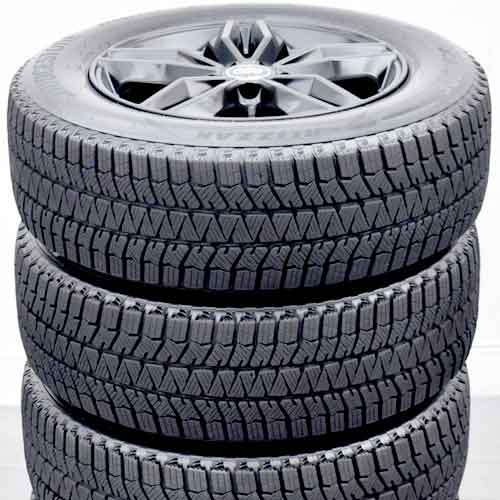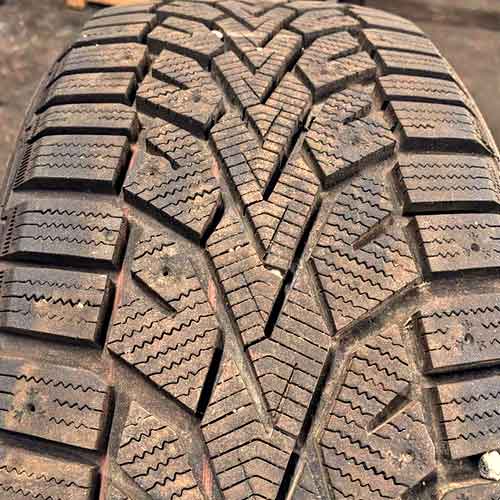Up for the challenge is General Altimax Arctic 12, famed for its superior load-bearing capacity, against the Bridgestone Blizzak WS90, admired for its reliable traction. Who will emerge victorious in this intense winter tire battle?

Table of Contents
Tire Sizes Info
The General Altimax Arctic 12 (review) comes in 14 to 19 inches with following.
- Speed ratings: T only.
- Load ratings: XL only.
- Tread depth: 12/32″ on all.
- Weight: 16 to 35 lbs.
On the flip side, the Bridgestone Blizzak WS90 offers you with 52 total sizes in 15 to 19 inches (rims) with following specs.
- Speed ratings: T or H.
- Load ratings: SL or XL.
- Tread depth: 11 or 12/32″.
- Weight: 17 to 29 lbs.
Tread Appearance
The Bridgestone Blizzak WS90 (review) tire’s tread design really impresses you with its resilient and well-thought-out directional pattern.

The tread primarily consists of three notable ribs, where the middle one is being continuous, meaning, there are no proper blocks formation there.
This rib has a lot of tiny tread features. You see multiple wave like sipes, along with lateral slits, which vary in thickness.
Moreover, you also see bigger notches, shaped as V, looking at both sides of the tread (laterally).
The shoulder lugs also features multiple notches.
You can see on of those facing the middle, and the other, which seem to be splitting up these blocks further.
Apart from that, you also see multiple-angles sipes on these blocks, which add to the overall biting abilities.
And yes, as these lugs are separated by wide tread voids, you also get superb self cleaning abilities as well.
On the other hand, General Altimax Arctic 12 features a more blocky tread design (of directional pattern).

Here the central lugs are sitting on a continuous running secondary rubber layer, underneath.
These lugs feature a lot of sides to them, and have a ton of rectilinear sipes.
Moreover, their arrow shaped design allow them to have powerful in-groove notches too.
The surrounding blocks are thicker/fuller, and you see wave-like siping on them, as well as stud holes.
These blocks also have sharp edges to them, just like the central blocks. And they have in-groove notches too, though, they are facing the shoulder lugs.
Speaking of which, the shoulder blocks run in pairs, and are surrounded by widest of all tread voids (laterally arranged).
Moreover, these studable lugs are less aggressive and blocky, as they have minimal edges to them, and they are missing with any kind of notches, though they have wave-like sipes.
Ice Performance
When driving on ice, the Bridgestone Blizzak WS90 stands out as one of the best options available. It owes its superior performance to its unique tread design, featuring angled cuts and V-shaped notches that vary in size and slant in both lateral directions.
This, combined with an aggressively siped pattern, results in shorter braking distances and handling times.
On top of all that, the sipes you seen on Blizzak are just much more aggressive. Sure both tires have sipes with interlocking designs, but on WS90, the sipes have much more biting capability.
In contrast, the General Altimax Arctic 12 seems less equipped for icy conditions, given its larger tread voids and a smaller number of notches. Its main tread area struggles to keep a firm grip on packed ice, and its lack of multi-angled sipes reduces its overall ice performance.
That said, the General Altimax Arctic 12 does offer studdable lugs which can provide better traction in extreme icy conditions.
But overall, without studs, the Blizzak Ws90 takes the cake on icy terrains.
Dry Traction
In dry conditions, the Blizzak WS90 excels in both the directional grip and handling, the two main parts of overall dry performance.
In terms of grip which depends on the tread’s central area, the Blizzak comes with a more streamlined, continuous running rib, which offers a consistent contact patch to meet with the road.
This allows for faster braking and acceleration efficacy.
And in terms of handling which depends on shoulders, the tire offers more closed up voids, which provide greater rubber to road contact as the tire corners.
The General Altimax on the other side, besides lacking with wider grooves, also comes with a larger weight which causes an increased lug movement when cornering, reducing steering feedback and negatively affecting handling.
So Blizzak has the upper hand here too.
Tread Life
A tire’s tread life is significantly influenced by its rolling resistance, which, in turn, is determined by the tire’s weight and tread design.
It is for this reason that the lighter Bridgestone Blizzak WS90 outperforms in terms of tread life. Its lightness reduces the pressure with which its tread is pushed against the road, thereby minimizing friction and slowing down the wear rate.
Conversely, the heavier General Altimax Arctic 12 places more weight on a smaller area of the tire because of the larger gaps between its treads. This increases the wear rate and can potentially reduce the overall lifespan of the tire.
Wet Traction
For a tire, the ability to maintain grip on wet surfaces is paramount. The tread pattern and the rubber’s texture primarily influence this capability.
Now as you can see, both tires possess numerous tread voids that assist in dispersing water and reducing hydroplaning risk.
However, the Blizzak WS90 takes it a step further by featuring a mix of interlocking and straight sipes that efficiently channel and absorb water, leading to superior wet traction. Its densely packed sipes and optimal balance of rigidity and flexibility provide enhanced grip, especially during cornering.
While the General Altimax Arctic 12 does feature laterally oriented sipes and exhibits commendable resistance to hydroplaning due to its larger grooves, its overall wet grip does not compare to the Blizzak WS90.
Snow Performance
When evaluating the performance of tires in snowy conditions, both tires prove their worth with stellar performances, as they have been designed and built to function at optimum levels even in the face of the most challenging snowy terrains.
Though still, the General Altimax Arctic 12 stands out here, in comparison, as it manages fluffier snow better (where it lacks on ice, and packed up snowy terrains).
This is primarily due to the unique design of its tread pattern, which is more spacious and features lugs that provide snow to snow contact.
It’s tread voids capture snow particles in, more effectively, and provide contact on the ground with that lodged snow. This offer superior traction, as snow adheres better to snow as opposed to rubber.
In comparison, the Bridgestone Blizzak WS90 adopts a more minimalist design, especially when dealing with thicker snow, as it features more closed up, less aggressive tread pattern, which isn’t able to pick up snow as efficiently.
Comfort
The comfort level offered by a tire is a multifaceted attribute and is influenced primarily by two key factors: road noise and the capacity to absorb vibrations. Let’s dive deeper into these elements to grasp their implications on tire performance better.
Road Quietness
Road noise, an often overlooked but critical aspect of driving, is primarily a byproduct of air particles clashing against the tire tread walls. This generated noise can significantly influence the overall driving experience, making its reduction a crucial facet of tire design.
From this perspective, the Bridgestone Blizzak WS90 holds a clear advantage over its counterpart. This superior performance can be attributed to the WS90’s tread pattern, which incorporates a less voided or less open structure. The limited voids mean there’s less space for air to ricochet, reducing the noise generated as the tire rolls over surfaces.
This meticulous design consideration results in a quieter ride with the Blizzak WS90, thereby amplifying the comfort levels for both the driver and the passengers.
On the other hand, the General Altimax, characterized by its larger tread voids, offers more space for air to clash against the tread walls.
So you get a quieter ride on Blizzak WS90.
On Road Vibrations
A tire serves as the vehicle’s primary buffer against the irregularities of the road, its a secondary suspension system, if you will.
So tire’s ability to effectively absorb and mitigate vibrations caused by bumps, potholes, and other surface imperfections is a significant contributor to ride comfort.
And in this regard, we have a clear winner, the General Altimax, which offers exceptional vibration damping capabilities.
The tire’s distinctive tread design and compound composition equip it with superior abilities to absorb shocks.
When it encounters uneven surfaces or obstacles, its design allows for effective cushioning of these impacts. This leads to a smoother ride, minimizing the transmission of road vibrations to the vehicle’s chassis and thereby enhancing the overall comfort levels.
On the other side, the Blizzak lacks here, with its slightly lower capabilities to dampen the same degree of impacts.
Summing Up
Ultimately, the verdict comes down to this.
The Blizzak WS90 shows exceptional performance on icy surfaces and provides remarkable traction in dry conditions, all thanks to its detailed biting edges and unbroken center rib.
Moreover, it delivers superior fuel efficiency, courtesy of its lighter weight and aerodynamic design.
Additionally, it holds a slight edge in wet traction and offers a quieter ride, enhancing the overall driving experience.
On the other hand, the General Altimax Arctic 12 takes the lead on snowy terrains and showcases superior vibration absorption.
This superior performance is largely due to its open tread pattern and effective shock-absorbing design.
Although it carries more weight, leading to accelerated tread wear and reduced fuel efficiency, its performance on snow-covered surfaces and level of comfort on uneven roads are commendable.